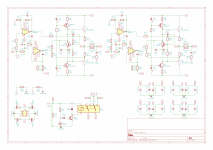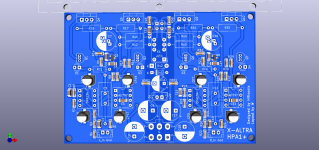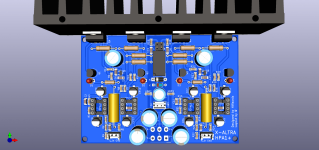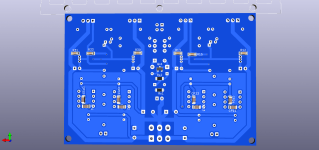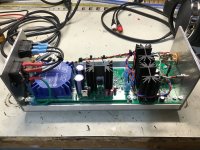Hi Andrew. In the schematic, there is C18 which is a 22uF cap between the two opamps, I’m a bit worry about it because X7R would varies and film cap would be pretty expensive. Should I skip it?
Hello Wolkegeist - that cap is there to block any DC that may be on the input stage (either because of the opamp offset or maybe any DC on the input source signal). The front end stage gain can be adjusted to quite high levels, so it is important that any offsets that are amplified because of this are not passed to the output stage because you don't want DC across the headphone coils.
If you want to go for a film cap, I would recommend you use OPA1642 opamps which are JFET input devices. Then you can make R33 and R12 100k and make C3 and C18 1uF film. This puts the LF -3dB point at 1.6 Hz. You could also use 2.2uF and 47k for similar results.,
The base design design uses LM4562 which have a worst case bias current of 70nA. Across 12k (originally specified for R33 and R12) this means an offset of up to 840uV which is negligible and why I went for the 22uF cap to ensure a low -3dB LF point. However, I understand many folks don't like electrolytics, even if they are bipolar types, so the film solution proposed above is the route I suggest you take if you are against them.
Do not use an X7R for signal coupling - only use these for supply rail decoupling, or DC rail decoupling. The capacitance varies strongly with applied voltage and with temperature and it will almost certainly introduce an audibly inferior result.
If you want to go for a film cap, I would recommend you use OPA1642 opamps which are JFET input devices. Then you can make R33 and R12 100k and make C3 and C18 1uF film. This puts the LF -3dB point at 1.6 Hz. You could also use 2.2uF and 47k for similar results.,
The base design design uses LM4562 which have a worst case bias current of 70nA. Across 12k (originally specified for R33 and R12) this means an offset of up to 840uV which is negligible and why I went for the 22uF cap to ensure a low -3dB LF point. However, I understand many folks don't like electrolytics, even if they are bipolar types, so the film solution proposed above is the route I suggest you take if you are against them.
Do not use an X7R for signal coupling - only use these for supply rail decoupling, or DC rail decoupling. The capacitance varies strongly with applied voltage and with temperature and it will almost certainly introduce an audibly inferior result.
Thanks for the advice Andrew. I will use film caps and set resistor like you mentioned. Would any Jfet input opamp works? And could I use a Jfet input opamp like OPA627/OPA134 for U1 and something like AD797 for U2? I would like to do my own layout with 1206 footprint if you allow it. 0603 is too small for my eye 🙂Hello Wolkegeist - that cap is there to block any DC that may be on the input stage (either because of the opamp offset or maybe any DC on the input source signal). The front end stage gain can be adjusted to quite high levels, so it is important that any offsets that are amplified because of this are not passed to the output stage because you don't want DC across the headphone coils.
If you want to go for a film cap, I would recommend you use OPA1642 opamps which are JFET input devices. Then you can make R33 and R12 100k and make C3 and C18 1uF film. This puts the LF -3dB point at 1.6 Hz. You could also use 2.2uF and 47k for similar results.,
The base design design uses LM4562 which have a worst case bias current of 70nA. Across 12k (originally specified for R33 and R12) this means an offset of up to 840uV which is negligible and why I went for the 22uF cap to ensure a low -3dB LF point. However, I understand many folks don't like electrolytics, even if they are bipolar types, so the film solution proposed above is the route I suggest you take if you are against them.
Do not use an X7R for signal coupling - only use these for supply rail decoupling, or DC rail decoupling. The capacitance varies strongly with applied voltage and with temperature and it will almost certainly introduce an audibly inferior result.
Ah. Thanks Andrew. I also read you article about the Micro Ripple Eater. Can it be included in the standard PSU? I was a bit confused because Standard PSU use 2 LM317 with split secondaries and 2 rectifier bridge, but it should be okay if I include MRE after the PSU right?Yes, you can split it like that with a JFET opamp in the front - it will work well.
Hi, the ripple eater won’t make any improvement to the Standard PSU. The total noise and ripple at full load is < 100 uV and the HPA1 PSRR is >100 dB at LF and still very high at 100 kHz.
The MRE is used to clean up an unregulated PSU for a power amp - it’s not really for a low load, low noise applications like this.
The MRE is used to clean up an unregulated PSU for a power amp - it’s not really for a low load, low noise applications like this.
Hi Andrew, I made a layout of the X-Altra HPA-1.
I added a CCS like the original HPA-1, with a red LED and A970/C2240 pair. The coupling cap from U1 to U2 changed to 1uF MKT with 100K. And supply voltage to +/-15V.
It'd be great if you can put some comments in.
Thanks.
I added a CCS like the original HPA-1, with a red LED and A970/C2240 pair. The coupling cap from U1 to U2 changed to 1uF MKT with 100K. And supply voltage to +/-15V.
It'd be great if you can put some comments in.
Thanks.
Attachments
wolkegeist,
apologies for the late reply. The constant current sources are very high in your implementation at >25mA. The opamps have to source current into and out of this and I think you will get quite high distortion as a result. I'm using c. 3mA standing current (4.7k on 15V rails) in my current implementation.
For the Zobel, you should take this from the junction of 1 Ohm resistors and not after the output series resistor. I would use 0.1uF (use film or NP0/COG - do not use X7R type devices) and 33 Ohms. The output series resistor is 3.3 Ohms in my implementation. You will need to check the stability with a capacitive load of 500pF to 1nF - you may need to increase the resistor value if the output rings excessively.
I would put a diode across Rs2 in the switch on delay driver for the relay - anode on the cap side, cathode to the supply rail. This will help discharge C51 quickly so if you turn it back on straight after turning it off, you will still get a delay.
apologies for the late reply. The constant current sources are very high in your implementation at >25mA. The opamps have to source current into and out of this and I think you will get quite high distortion as a result. I'm using c. 3mA standing current (4.7k on 15V rails) in my current implementation.
For the Zobel, you should take this from the junction of 1 Ohm resistors and not after the output series resistor. I would use 0.1uF (use film or NP0/COG - do not use X7R type devices) and 33 Ohms. The output series resistor is 3.3 Ohms in my implementation. You will need to check the stability with a capacitive load of 500pF to 1nF - you may need to increase the resistor value if the output rings excessively.
I would put a diode across Rs2 in the switch on delay driver for the relay - anode on the cap side, cathode to the supply rail. This will help discharge C51 quickly so if you turn it back on straight after turning it off, you will still get a delay.
Last edited:
Andrew,
I am casing my unit up will post picture when complete.One issue on the bench when I am using a portable player as a source I get a hum when paused and between tracks. I am hoping it will go away when introduced to my main system in the living room due everything grounded to the same point, but is there a way to prevent hum from the potable devices?
Thanks Bill
I am casing my unit up will post picture when complete.One issue on the bench when I am using a portable player as a source I get a hum when paused and between tracks. I am hoping it will go away when introduced to my main system in the living room due everything grounded to the same point, but is there a way to prevent hum from the potable devices?
Thanks Bill
Hello Bill,
you may be picking up noise via the connection between the portable player and the HPA-1.
If you hold the player, does the noise change? does the noise change if you move the interconnect around? If you move the HPA-1 around, does the noise change?
What power supply are you using?
you may be picking up noise via the connection between the portable player and the HPA-1.
If you hold the player, does the noise change? does the noise change if you move the interconnect around? If you move the HPA-1 around, does the noise change?
What power supply are you using?
Hello Bill,
you may be picking up noise via the connection between the portable player and the HPA-1.
If you hold the player, does the noise change? does the noise change if you move the interconnect around? If you move the HPA-1 around, does the noise change?
What power supply are you using?
Sorry for long reply, actually it hums with no input. I’m checked the input rca and the ground has continuity to case unsoldered them and still has continuity from the ground to case. Tight fit edge of boards contacting case, could that be issue?
Attachments
Well when I moved the input wire around hum would come and go so I replaced it with a piece of shielded cable. Now I hear just the faintest hum. The portable players - tried 2 when you stop the music it likes to hum, but when I tried my roon endpoint it works fine so it must be something about the portable players. I still would like to get rid of the faint hum, could be the open cabinet picking up something from the lights in the garage.
The headphone socket must be completely isolated from the chassis so the headphone signal return must only go through the amplifier boards and no other route. It looks like you might be getting a loop through the chassis because the type of socket you are using has the ring in contact with the metalwork. Unscrew the socket so it’s floating and then try again - let me know what you get.
(nice compact looking build BTW!)
(nice compact looking build BTW!)
funny, I had a nice isolated locking plug set aside for it and misplaced it and used that one. Thought it would make a difference but it didn’t. I figured out the small residual hum is the inputs being so close to the transformer. I was able to route the wire a little better but I would have to remake the case to get rid of it. For some reason Digikey has no stock on talema but has amigas, they may not be a quite.
Last edited:
Is your socket proper completely isolated from the chassis? Also, make sure when you plug your headphones in, the plug rim is not shorting to the chassis.
I’ll have to add a note about that in the build doc. (Applies to any HP amp BTW). A good brand is Neutrik with the nylon nut - the whole thing is insulated. If you use the chrome nut version, make sure when you plug your phones in the Jack ring rim does not short to the chassis through the nut.
Last night I rigged up one of my HPA-1’s plus a Standard PSU and an iPod as a source and took a listen. My Tek has a peak reading option. I cranked the volume up and had to take the phones off my head at 1.4 V pk-pk. I then cranked it up further but stopped when the reading got to 1.92 V pk-pk.
I am using Audio Technica ATH 90 ‘Air’s which are open back c. 32 Ohms.
The point of this post is just to remind folks that although a lot of headphone amps may be boasting high standing current class A operation (the HPA-1 included), for the most part, the onset of physical pain will start well before the headphone amp gets anywhere near full output - even with inefficient cans.
Separately, don’t over do it with the volume. Permanent damage starts as low as 105 dB for 30 minutes and is one of the causes of tinnitus.
😊
I am using Audio Technica ATH 90 ‘Air’s which are open back c. 32 Ohms.
The point of this post is just to remind folks that although a lot of headphone amps may be boasting high standing current class A operation (the HPA-1 included), for the most part, the onset of physical pain will start well before the headphone amp gets anywhere near full output - even with inefficient cans.
Separately, don’t over do it with the volume. Permanent damage starts as low as 105 dB for 30 minutes and is one of the causes of tinnitus.
😊
- Home
- Amplifiers
- Headphone Systems
- X-Altra HPA-1 Class A Headphone Amplifier
